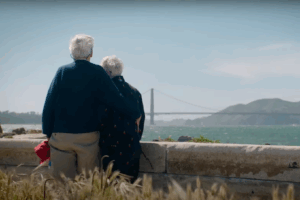Photo by Kimberly Bryant.
If you want to grow old, you can — but you don’t have to. You can grow up and die, but you don’t have to grow old and die.
— Aging in America
Here’s some food for thought: what does it mean to have a good old age? When you envision your life in five or ten years from now, where are you? What are you doing, and whom are you with? In other words, what does living the good life as an elderly person look like — and, more importantly, what does it feel like?
Documenting a culture of old age
Delving deeper into this broad, fascinating subject, the documentary film Aging in America: The Years Ahead explores the relationships and emotional lives of an array of elderly people living in the United States. The experience of old age has changed dramatically over the past several decades; and yet, this subject remains, for the most part, off the discussion table in mainstream media. Fortunately, there is work like Aging in America, which presents a sensitive depiction of what’s really on the minds of America’s elders. Through a series of personal vignettes that bring us inside their lives, we’re able to better understand and empathize with them.
Writer-photographer team Julie Winokur and Ed Kashi spent seven years doing research and fieldwork across the country to collect the stories of an aging demographic whose stories, too often, are left untold. Most significantly, the film “challenges the culture of aging in America.”
Aging in the past, present, and future
Made in 2003, the film provides a thoughtful depiction of what aging was like nearly a decade ago. Alongside our elders’ touching stories, the documentary also investigates the socio-economic context at play. For instance, Winokur explores issues related to women (who, at the time, “accounted for 70% of older Americans living in poverty”); health care (the number of “employers offering retiree health benefits” was on a steady decline); and housing hardship (high-priced San Francisco saw approximately “500 elders evicted each year”). When viewed today, the film becomes a thought-provoking piece that inspires us to question what has changed since then — and what has stayed the same.
The film also encourages questions about the future, drawing attention to one particularly interesting fact: at the current rate of aging — “another baby boomer turns fifty every 7.5 seconds.” Also, “by 2030, one quarter of the United States’ population will be over 65, and by mid-century, the senior citizen population is expected to reach eighty million, outnumbering the population of young people for the first time in history.”
A special friendship
The vignette above invites us to share in the unexpected friendship between ninety-year-old Arden Peters and 76 year old Warren DeWitt. We learn that Peters’ wife is afflicted with Alzheimer’s and Parkinson’s, rendering her entirely dependent on Arden — who found himself struggling to manage the physical and emotional challenges of caring for his ill wife, when a chance encounter at Wal-Mart with DeWitt changed everything. The two became steadfast friends, with DeWitt making significant changes in his own life to help Peters care for his wife. Peters, meanwhile, inspired DeWitt through his devotion to his wife and determined perseverance in the face emotional turmoil. In a moving montage, Kashi’s still photographs convey (with necessary sensitivity and respect) the inevitable death of Peters’ wife, and DeWitt’s unwavering support of the older man. For the remainder of Peters’ days, we see DeWitt stand by his friend.
Stories such as this are invaluable to our culture because they pull back the curtains from the aging process to reveal the vibrant human beings glowing beneath the sagging skin and well-worn wrinkles, the beauty of relationships, and the triumph of the human spirit to go on living each day with the power of love.
If you are unsure of how to best help an aging loved one, the trained and compassionate staff at the Institute on Aging is here to help you make that decision and gain the best in at-home senior care. Contact us to find out more.







